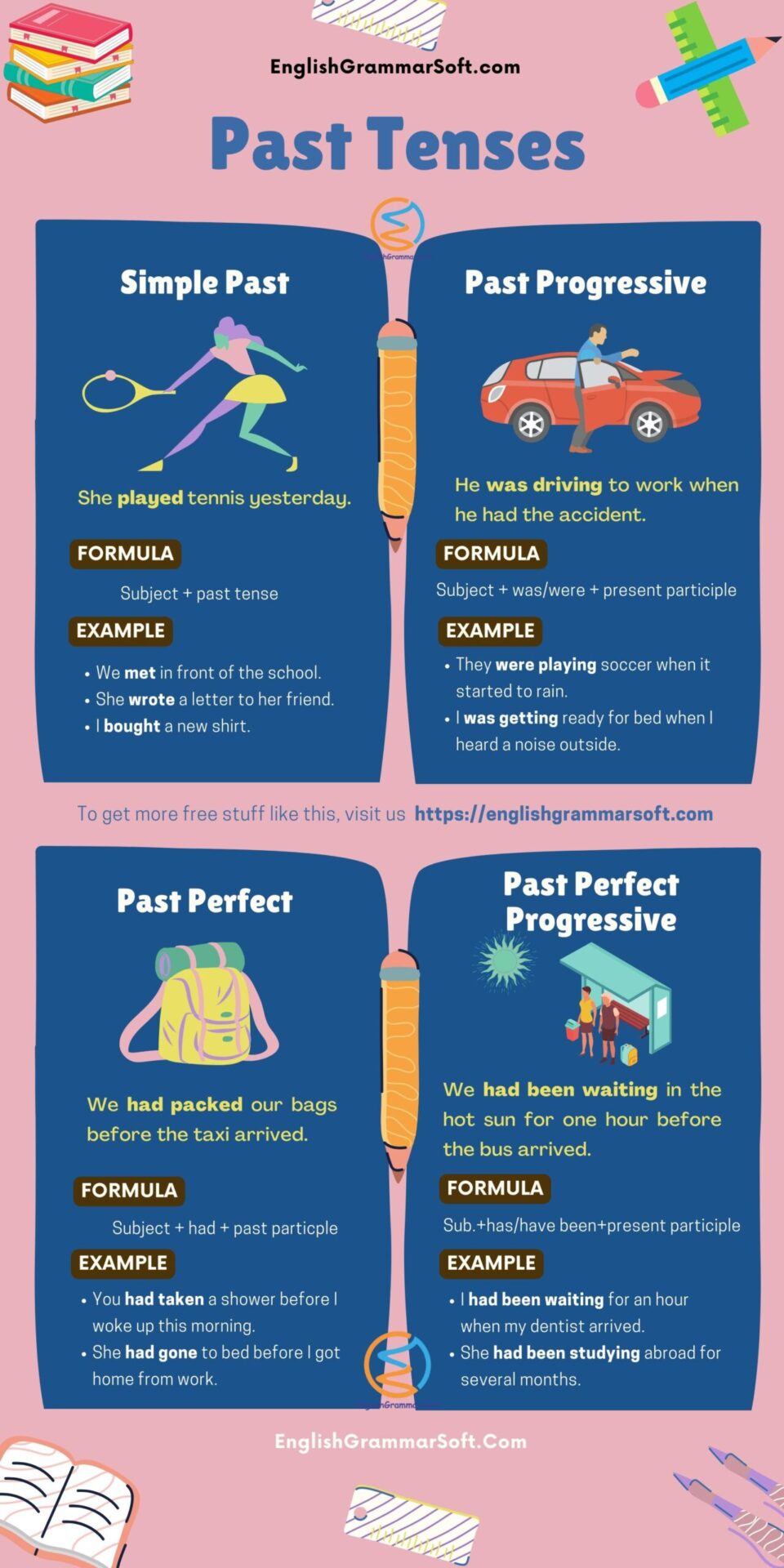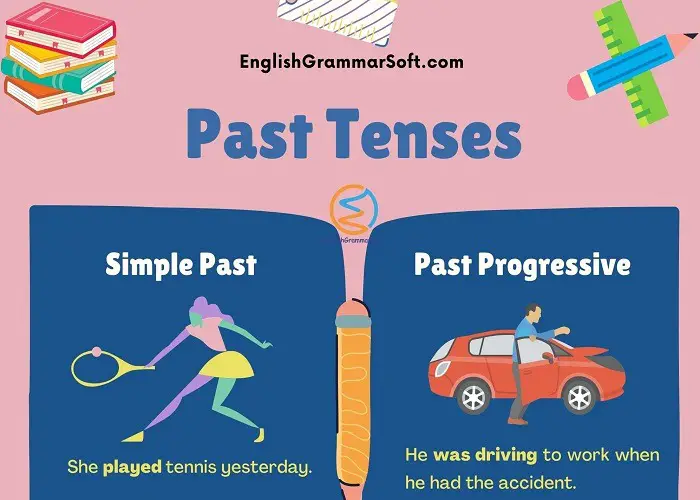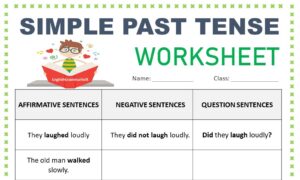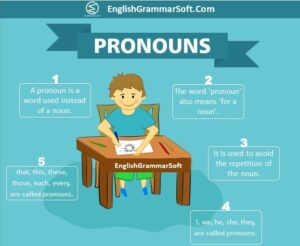Past Tenses of Verbs (Examples & Structure)
Past tenses refer to an action or state that has occurred in the past. These are used to describe actions that have already been completed at the time of speaking, or an event that happened in the past. These can also refer to actions which are no longer taking place at the time of speaking.
There are four types of past tense in English, each with its own function and purpose. These are simple past, past continuous, past perfect and past perfect continuous tense. The past tense is often used with a time expression such as “yesterday” or “last week”. The past tense can be formed using the regular verb endings (-ed for regular verbs and -d for irregular verbs), or by using the auxiliary verbs “was/were” + present participle or “had” + past participle.
Examples
- I played tennis yesterday. (regular verb)
- I was at the park yesterday. (auxiliary verb “be”)
- I had a sandwich for lunch yesterday. (auxiliary verb “have”)
- I did my homework last night. (auxiliary verb “do”)
What are the types of past tenses?
Past tense has following four types:
- The simple past tense is used to describe an action that happened at a specific time in the past. For example: I played tennis yesterday.
- The past progressive tense is used to describe an ongoing action that was happening at a specific time in the past. For example: I was playing tennis when my phone rang.
- The past perfect tense is used to describe an action that happened before another action in the past. For example: I had finished my homework before I watched TV.
- The past perfect progressive tense is used to describe an ongoing action that was happening before another action in the past. For example: I had been playing tennis for an hour when my phone rang.
Let’s have a closer look at them!
What is simple past?
The simple past is a verb tense that expresses action or occurrence in the past. To form the simple past, you use the past form of the verb (V2). For Example, I walked.
When do we use the simple past tense?
We use simple past tense to talk about an action that happened in the past, and it’s mostly used for actions that happened recently, or within a short time period.
Examples
- To talk about something that happened in the past but not exactly on a specific day or at a specific time: (Examples: I went to school yesterday. I lived in London when I was young.)
- For something that happened regularly in the past: (Example: My father used to drink tea every morning before going to work.)
- To talk about an action or event that continued over a period of time: (Example: I went camping every summer when I was young.)
- When talking about an action that took place before another action or event happened: (Example: Before he left home, he had breakfast.)
Structure of Simple Past Tense
To form the simple past tense, use this structure
Subject + past tense
He/She/I/We/You/They + played + tennis yesterday.
| Simple Past Tense | Structure | Example |
|---|---|---|
| Simple Past Affirmative | Subject + past tense | He played tennis yesterday. |
| Simple Past Negative | Subject + did not + base form | He did not play tennis yesterday. |
| Simple Past Interrogative | Did + subject + base form + ? | Did he play tennis yesterday? |
20 Examples of Simple Past Tense
- She didn’t see the movie last week.
- James failed his driving test, so he was very upset.
- What did you do at the weekend?’
- Last year, I spent my summer holiday in Spain.
- Did you have a good time at the party last night?
- We didn’t go out because it was raining.
- Tom broke his arm when he fell off his bike.
- She cooked dinner for us.
- You broke my favorite vase.
- She slept for eight hours last night.
- I made a cake yesterday.
- You looked very tired when you got home from work yesterday.
- We met in front of the school.
- She wrote a letter to her friend.
- I bought a new shirt.
- He wasn’t very nice to me yesterday.
- She took a nap this afternoon.
- I cleaned my room this morning.
- He used to play football every Saturday afternoon.
- I learned how to swim when I was young.
What is Past Continuous Tense?
The past continuous (progressive) tense is used to describe an ongoing action that occurred in the past. For example, “I was walking to the store when I saw a cat.” In this sentence, the action of walking happened in the past and was interrupted by the action of seeing a cat.
Examples
- I was walking to the store.
- He was eating lunch.
- They were playing soccer.
Remember, the past progressive tense is used to describe an action that was happening at a specific time in the past. It is not used to describe an action that simply happened in the past without specifying when it occurred.
Why Do We Use Past Continuous Tense?
Past continuous tense has two different uses.
Use 1: to show that something was happening at some time in the past.
- I was working as a teacher in an elementary school.
- The music was playing very loudly at the party.
Use 2: to show that something began and continued for some time before another action in the past.
- I was studying English when my wife came home from work.
- He was walking around the town when he saw a football match on TV.
Structure of Past Continuous Tense
The structure of simple present tense is:
Subject + was/were + present participle
| Past Continuous Tense | Structure | Example |
|---|---|---|
| Affirmative Singular | Subject + was + present participle | I/He/She was playing tennis yesterday. |
| Plural | Subject + were + present participle | We/You/They were playing tennis yesterday. |
| Negative Singular | Subject + was + present participle | I/He/She was not playing tennis yesterday. |
| Plural | Subject + were + present participle | We/You/They were not playing tennis yesterday. |
| Interrogative Singular | Was + subject + present participle+? | Was I/he/she playing tennis yesterday? |
| Plural | Were + subject + present participle+? | Were we/you/they playing tennis yesterday? |
20 Example Past Continuous Tense
- I was studying English when she called me.
- He was walking to school when he saw the accident.
- Was she sleeping when you arrived?
- They weren’t paying attention when the teacher asked them a question.
- Were you listening to music when I called you?
- He wasn’t working when I saw him yesterday.
- He was driving to work when he had the accident.
- They were playing soccer when it started to rain.
- I was getting ready for bed when I heard a noise outside.
- She was taking a shower when the phone rang.
- He was doing his homework when his mom got home from work.
- They were dancing when the music stopped.
- We were tidying up the house when they arrived.
- We were having a party at our house last night.
- I was doing my homework when my pencil ran out of lead.
- You were sleeping when I left for school this morning.
- I was going to the mall but I got stuck in traffic.
- We were swimming when it got dark.
- I was watching TV when the fire broke out.
- He was crossing the street when he was hit by a car.
- She was helping her mother with cooking when her father arrived home late at night.
What is Past Perfect Tense?
The past perfect tense is used to talk about an event that happened before another event in the past. In other words, it’s used to put two events in chronological order. For example, “I had finished my homework before he arrived.”
To form the past perfect, you use the past tense of the verb “to have,” which is “had,” and then add the past participle of the main verb. The main verb is the verb that shows the main action or event in a sentence. In the example above, the main verb is “finished.” The past participle of regular verbs usually ends in “-ed” (e.g., played, looked, listened).
However, there are many irregular verbs with different endings (e.g., bought, brought, thought, caught). To form the past perfect tense of irregular verbs, you need to know the correct past participle form.
When using the past perfect, you can use either “before” or “after” to show which event happened first. For example, “I had cleaned my room before she arrived.” In this sentence, it is implied that cleaning my room is an event that happens before she arrives.
However, if we want to be more specific, we can use “after.” For example, “I had cleaned my room after I finished my homework.” This sentence implies that there are two events happening: cleaning my room and finishing my homework. And we know that finishing homework happens before cleaning the room.
Where We Use Past Perfect Tense?
The past perfect tense is used to talk about an action that happened before a past time.
The past perfect tense is used in the following situations:
- When you want to stress the duration of an action relative to a past time. For example: We had waited for hours before they arrived.
- After certain expressions of time like “before”, “after”, “as soon as”, “as long as”, etc. For example: I had eaten meal before I left for work.
- To show cause and effect relationships between two past actions or events. For example: The boy had studied hard for his test so he got an A+.
- When one action happens before another action takes place in the same sentence or clause and is related to it with a conjunction like when, after, until, while or because (in this case called subordinate clauses). For example: She could not pay her bill because she had lost her wallet.
Structure of Past Perfect Tense
Structure of present perfect tense is
Subject + had + past participle
Subject (He/She/It/I/We/They/You) + had + past participle
| Past Perfect Tense | Structure | Example |
|---|---|---|
| Affirmative | Subject + had + past participle | I had played tennis before she arrived. |
| Negative | Subject + had not + past participle | I had not played tennis before she arrived. |
| Interrogative | Had + subject + past participle+? | Had I played tennis before she arrived? |
20 Example of Past Perfect Tense
- I had finished my homework before she arrived.
- I had made dinner before you got home from work.
- You had taken a shower before I woke up this morning.
- She had gone to bed before I got home from work.
- We had packed our bags before the taxi arrived.
- I had done the laundry before you got home from school.
- You had fed the dog before I got home from work.
- The thief had escaped when the police arrived.
- We had just finished our lunch when the power went out.
- Yesterday, I realized that I had left my phone at home.
- Had you ever been to Barcelona before you moved there?
- I had looked everywhere for my keys before I realized that I had left them at work.
- She had studied hard for the test, but she still failed.
- We had wanted to go to the beach, but it rained all day long.
- I had tried to call you yesterday, but your phone was turned off.
- They were angry because we had not invited them to the party.
- I was so surprised when I saw her because I hadn’t seen her in years.
- I had slept for eight hours before my alarm went off.
- The flowers had wilted by the time I got home from work.
- He had mowed the lawn before it started raining.
- She had forgotten her phone, so she couldn’t call a taxi.
What is Past Perfect Continuous Tense?
The past perfect continuous (progressive) tense is a verb tense used to describe an action that was completed in the past and then continued for an extended period of time. Formula of past perfect continuous tense contains auxiliary verb (had been) and present participle (-ing form of verb).
Why We Use Past Perfect Continuous Tense
The past perfect continuous tense is used to show that something started in the past and continued up to another time.
Past perfect continuous tense uses
- Before a time phrase
-The car had been making a strange noise for two hours before he brought it to the mechanic.
- After a time phrase:
-I had been reading the book for two hours after talking to Mary.
Structure of Past Perfect Continuous Tense
To make past perfect continuous tense, use this structure.
Subject + had been + present participle
Subject (He/She/It/I/We/You/They) + had + present participle
Formula for both singular and plural subjects is same.
| Past Perfect Continuous Tense | Structure | Example |
|---|---|---|
| Affirmative | Subject + had been + present participle | He had been playing tennis for one hour. |
| Negative | Subject + had not been + present participle | He had not been playing tennis for one hour. |
| Interrogative | Had + subject + been + present participle + ? | Had he been playing tennis for one hour? |
20 Examples of Past Perfect Continuous Tense
- I had been working on my computer for three hours when my boss called me.
- She had been looking for a job for several months before she found work at the local bank.
- We had been waiting in the hot sun for two hours before the bus arrived at our stop.
- She had been taking care of her sick uncle for a year.
- We had been living in New York for five years when we decided to move south.
- I had been traveling around Europe for three weeks when my bag was stolen from my hotel.
- I had been waiting for an hour when my dentist arrived.
- The rain had been falling heavily all morning when I decided to go out running.
- For the last 1 hour he had been cleaning the house.
- I had been having trouble walking due to my injury.
- Tom had been trying to get a job for two months when he got one.
- I had been studying Japanese for six months when I went to Japan in March.
- I had been living in Germany for three years before I started learning German.
- He had been grading his essays for months before he finally got it right.
- We had been cleaning up the attic for hours.
- The kids had been looking forward to going to the amusement park.
- She had been shouting over the loud crowd before she realized that the music was too loud.
- I had been playing football for more than six months last year.
- I had been living in London for a few weeks before I settled on somewhere to live.
- I got pretty good grades in the test which was not too surprising since I had been studying very hard the whole semester before it.
- I managed to see many attractions that I had not seen when I had been travelling around the country.

Further Reading






